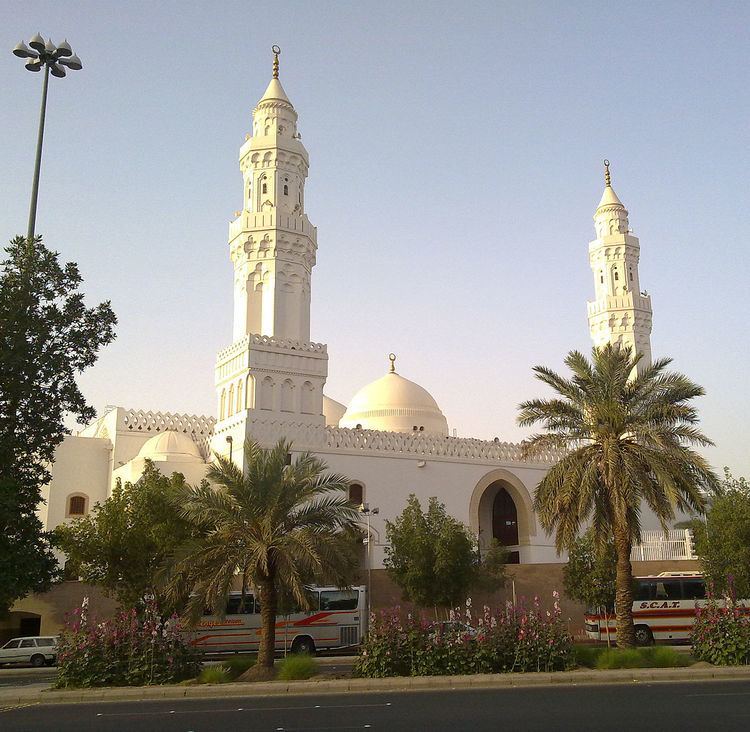Completed 623 Number of minarets 2 Number of domes 1 | Affiliation Islam Capacity 2,000 | |
 | ||
Similar Quba Mosque, Mount Uhud, Al‑Masjid an‑Nabawi, Al‑Baqi', Jabal al‑Nour | ||
Masjid al-Qiblatayn (Arabic: المسجد القبلتین), or the Mosque of the Two Qiblas, is a mosque in Medina that is historically important for Muslims as the place where, after the Islamic prophet Muhammad received the command to change the direction of prayer (qibla) from Jerusalem to Mecca, the entire congregation led by a companion changed direction in prayer. Thus it uniquely contained two prayer niches (mihrabs). Recently the mosque was renovated; the old prayer niche facing Jerusalem was removed, and the one facing Mecca was left.
Contents
The Qiblatayn Mosque is among the three earliest mosques in Islam's history, along with Quba Mosque and Al-Masjid al-Nabawi.
History
The name of the mosque goes back to the beginning of Islam when the companions of Muhammad named it after an event that took place. Muhammad received revelation from Allah instructing him to take the Kaaba as the Qiblah in the early morning hours of the day. He announced this to his companions in his own mosque (Masjid-al-Nabwi), after which the news began to spread. A companion who heard this went to Masjid al-Qiblatayn to share this news. Upon arriving, he noticed the congregation were already engaged in the afternoon prayer (Asr). He called out from the back of the mosque that the change of direction has been ordained, and upon hearing this, the imam (leader of the prayer) immediately turned around to face Mecca, and those praying behind him also did so. After this, the mosque in which this incident occurred came to be known as Masjid al-Qiblatayn (i.e. 'Mosque of the Two Qiblas'). Many pilgrims who go to Mecca for hajj often visit Medina where some end up visiting the notable Qiblatayn because of its historic significance.
Hadith
Sahih Bukhari says;
Structure
The main prayer hall adopts rigid orthogonal geometry and symmetry which is accentuated by the use of twin minarets and twin domes. Living accommodations for the Imam, the Muezzin and the caretaker are discreetly grouped in one block to the west of the main structure. The difference in level at the southeast corner of the site has been exploited to incorporate a sub-basement level which serves as the ablutions area for worshippers.
To the north, where the ground level is lower, the prayer hall is raised one-storey above ground level. Entry to the prayer hall is from the raised courtyard, also to the north, which can be reached by stairs and ramps from the main directions of approach. The prayer hall consists of a series of arches which support barrel-vaults running parallel to the qibla wall. These vaults are interrupted by two domes which establish an axis in the direction of Mecca.
The main dome to the south is raised on a drum of clerestory windows which allow light to filter into the interior directly above the mihrab. The second, false dome is linked to the first by a small cross-vault to symbolise the transition from one qibla to another. Below it, a replica of the mihrab found in the lower chamber of the Dome of the Rock in Jerusalem reminds onlookers of the oldest extant mihrab of Islam. Externally, the architectural vocabulary is inspired by traditional elements and motifs in a deliberate effort to offer an authentic image for an historic site.
The mosque is located on the north-west of the city of Medina, on Khalid bin al-Waleed road. The mosque was initially maintained by Caliph Umar ibn al-Khattāb. By the rise of the Ottoman Empire the mosque was maintained by Sultan Suleiman the Magnificent who renovated and reconstructed it.
